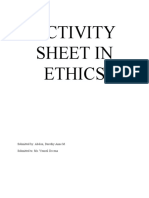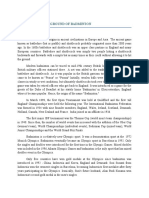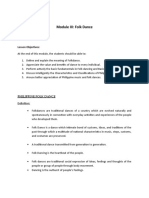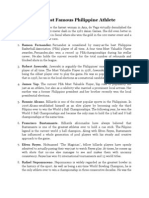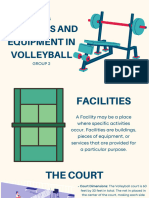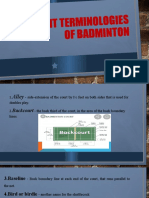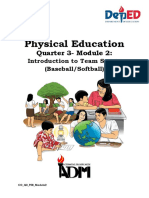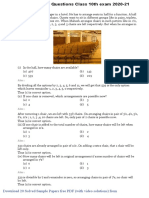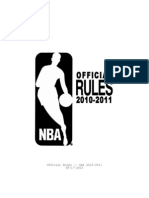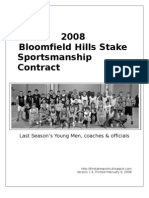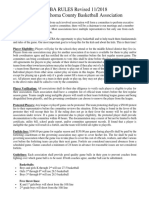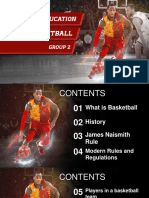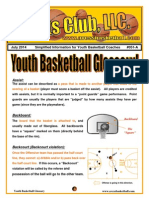UNIVERSITY OF CALOOCAN CITY
Biglang Awa St., Corner Catleya St., EDSA, Caloocan City
COLLEGE OF BUSINESS AND ACCOUNTANCY
ENGAGE
Activity1: Correct Positions
Directions: Look at the basketball board and identify each player position by means of writing
their role in accordingly in the number below.
Write your answers to the table below:
1. Point Guard
2. Shooting Guard
3. Small forward
4. Power forward
5. Center
BASKETBALL COURT
EXPLORE
1 | Page
� UNIVERSITY OF CALOOCAN CITY
Biglang Awa St., Corner Catleya St., EDSA, Caloocan City
COLLEGE OF BUSINESS AND ACCOUNTANCY
Activity 2: Point the Word
Directions: Using the information you got from the previous activity, answers the question
below
1. Explain the role of each player above. (2 points each)
Point Guard
The Point Guard is usually the shortest but the best ball handler on the team. Also known as the
‘coach on the floor’ or the ‘floor general’, a point guard is responsible for directing plays.
He needs to have good court vision to create open shots for the receivers as well as drive the ball
down the court and initiate offensive plays.
Point Guards need to have an excellent long-distance shooting, though it’s not quite as crucial as
for shooting guards, some point guards take as many shots as shooting guards.
Shooting Guard
Potentially the shortest player on the team, the Shooting Guard is the team’s best outside shooter.
Besides being able to shoot well, the Shooting Guard needs to be good at dribbling fast, passing
and having court vision by seeing the court.
He is also responsible for driving the ball down the court and setting up offensive plays.
A good Shooting Guard will be a threat to his opponent as he’s able to score from anywhere on
the court.
Small forward
The Small Forward is usually the shorter of the two forwards on the team but plays the most
versatile role out of the main five positions.
He must have enough height and the ability to play on the inside as well as agility to play on the
outside, similar to a shooting guard. Small Forwards are usually the second or third best shooters
on the team and should be able to do a little bit of everything on the court.
Power Forward
Power Forwards are usually the second tallest in the team and are the closest to the centre in
terms of physical attributes and playing style but with more speed.
They are often the most versatile player, being able to score in the paint as well as being able to
shoot from midrange. It will be more effective if they’re able to land a three-point consistently.
2 | Page
� UNIVERSITY OF CALOOCAN CITY
Biglang Awa St., Corner Catleya St., EDSA, Caloocan City
COLLEGE OF BUSINESS AND ACCOUNTANCY
Defensively, they are required to have the strength to guard bigger players close to the basket.
Centre
The centre is usually the team’s tallest and strongest player and is positioned under the basket.
He is also required to be physically domineering with more physical strength and athleticism.
On the offensive play, most centres do not consistently score midrange or beyond the arch.
Instead, most of their points should be from offensive rebounds and are also required to block
defenders to open other players up for driving to the basket.
On the defence, the centre is responsible for keeping the opponent from shooting by blocking
shots and passes in the vital area. They’re also expected to fight for rebounds as they’re usually
taller physically.
EXPLAIN
Activity 3: Think and Share
Directions: Read and understand the concepts below. You can raise questions that you want to
clarify where students and teacher must collaborate in this part.
Simplified Rules in Basketball
Length of a basketball game
● The basketball game consists of four quarters of 10 minutes each.
● Teams play one-way for two quarters, the other way for the next two.
● There is a two-minute interval between the first and second period, and also between the third
and fourth period, with 15 minutes for halftime.
● Coaches can call two one-minute timeouts at any time during the first half and three timeouts in
the second half.
● The clock stops when the referee's whistle blows. It stays stopped if free throws are being taken
and starts again when the ball touches a player on court — so you get a full 40 minutes of actual
basketball play.
Time limits in basketball
There are also time limits on a player in possession of the basketball with five main rules:
3 | Page
� UNIVERSITY OF CALOOCAN CITY
Biglang Awa St., Corner Catleya St., EDSA, Caloocan City
COLLEGE OF BUSINESS AND ACCOUNTANCY
24-second rule
After a team gains possession of the ball, they have 24 seconds to shoot. Possession is handed to
the other team if they fail to do so.
8-second rule
When a player has the ball in their own half or ‘backcourt’, they have 8 seconds to move the ball
over the halfway line into the ‘frontcourt’. Otherwise, they will lose possession.
5-second rule
A closely guarded player holding the ball has 5 seconds to either pass or advance the ball toward
the hoop. When called, possession of the ball goes to the opposite team.
3-second rule
A player can only be in the opposition's rectangular ‘key’ area under the basket for 3 seconds. A
foul will be called if the player does not leave within those 3 seconds.
Types of basketball infringement
Basketball players can be penalized for making an infringement or foul on another player, with
the loss of possession or the award of a ‘free throw’.
● Personal foul — this is when illegal body contact occurs between opposing players. Common
examples are charging, blocking, holding, illegal guarding, pushing, illegal screening, hand
checking, and illegal hand use. A personal foul result in either a player taking free throws or a
team losing possession of the ball.
● Charging — called by the official when an attacking player moving with the ball runs straight
into a defender.
● Blocking — a defensive player may not stand in the way or ‘block’ a dribbling player unless that
defender has established a legal guarding stance.
● Holding — this is when personal contact is made with an opponent to slow their movement.
● Illegal guarding — when a defending player bumps into an opponent from behind.
● Pushing — this is exactly as it sounds, and applies even when a player does not have possession
of the ball.
● Illegal screening — an attempt to slow down or stop an opponent who does not have control of
the ball.
● Hand checking — when a defending player uses their hands to grab or slow an opponent.
● Illegal hand use — when contact is made on an opponent when they are attempting to release the
ball.
Other types of basketball infringement include:
● Technical foul — these are awarded against any player or coach for unsportsmanlike behavior
such as swearing or arguing with a referee. This leads to at least one free throw and possession of
the ball. If a player or coach receives two technical fouls, he or she is removed from the game.
● Persistent fouling — this can lead to a player being removed from the game. If a player commits
five fouls they must leave the game permanently, but can be substituted.
● Team foul — this is called when a team has committed five fouls of any kind in any one period.
The opposing team is awarded with two free throws.
● Violation — a violation of the rules covers such things as an illegal dribble or not releasing the
ball within the specified time limits. Possession is handed to the opposition.
● Backcourt violation — an attacking player with the ball may not cross back over the halfway line
once he or she has advanced the ball beyond it.
4 | Page
� UNIVERSITY OF CALOOCAN CITY
Biglang Awa St., Corner Catleya St., EDSA, Caloocan City
COLLEGE OF BUSINESS AND ACCOUNTANCY
Basketball scoring
The scoring and points system of basketball comprises the following -
The number of points scored by a shot depends on the position of the player when they release
the ball.
● Outside the three-point line (3pts) — the highest number of points that can be achieved is when a
basket is scored from outside the three-point line.
● Inside the three-point line (2pts) — any basket shot inside the line earns two points.
● Free throw (1pt) — a free throw from the free-throw line is worth one point. It is an
unchallenged shot at the basket, awarded after a foul by the opposition.
Types of basketball shot:
● Jump shot — a shot performed while jumping in the air. The ball is released at the highest point
off the ground, and is often used when shooting over a defender trying to block the ball.
● Lay-up — a shot when a player moves to the basket with the ball and rolls it off his or her
fingertips into the basket.
● Bank shot — a shot in which the ball touches the backboard before it goes into the hoop.
● Dunk (or Jam) — a player slams the ball into the basket from jumping into mid-air.
● Hook shot — a one-handed shot with the shooter facing sideways to the hoop and arcing the ball
over the defending player to score.
● Free throw — a free shot taken from the foul line as the result of a foul.
ELABORAT
E
Activity 4: Synthesizing Ideas
Guide Questions:
1. What is your top important rules in playing Basketball? How it improves our chance of
winning?
For me it’s the time limit. Because of this, the player are aware of their moves. If you’re
much aware of your limit, we can say that we are taking much advantage than the
opponent. By this, you can avoid violation.
2. Why is it important to learn the rules and regulation in Basketball? \
However, rules are not only set to ensure a standard level of play but are importantly
done to ensure player safety, integrity of the game, and in an attempt to create as fair a
competition as possible.
EVALUATE
5 | Page
� UNIVERSITY OF CALOOCAN CITY
Biglang Awa St., Corner Catleya St., EDSA, Caloocan City
COLLEGE OF BUSINESS AND ACCOUNTANCY
Activity 5: My Reflection
Directions: Using the information you’ve learn formulate your self- reflection by answering the
following questions that will be given on the day of schedule of PE.
RUBRICS
6 | Page
� UNIVERSITY OF CALOOCAN CITY
Biglang Awa St., Corner Catleya St., EDSA, Caloocan City
COLLEGE OF BUSINESS AND ACCOUNTANCY
REFERENCE
S
7 | Page
� UNIVERSITY OF CALOOCAN CITY
Biglang Awa St., Corner Catleya St., EDSA, Caloocan City
COLLEGE OF BUSINESS AND ACCOUNTANCY
https://www.realbuzz.com/articles-interests/sports-activities/article/the-rules-of-basketball/
https://www.myactivesg.com/Sports/Basketball/How-To-Play/Basketball-Rules/Basketball-
Positions-and-Roles
8 | Page








